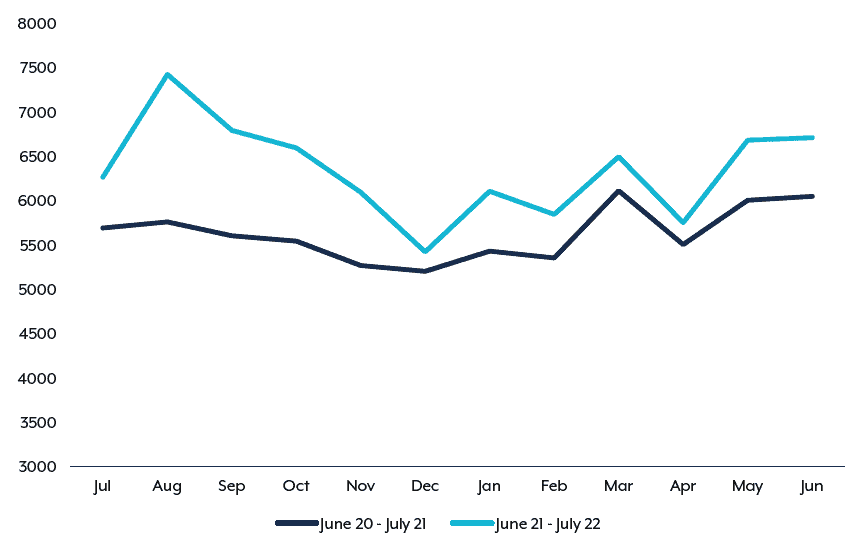From enabling business growth and digital transformation to enhancing security and delivering cost savings, it seems there’s nothing cloud infrastructure can’t do. We love to shout about the benefits of cloud adoption – but that doesn’t mean everything is always peachy.
Moving to the cloud in Australia comes with specific cloud migration challenges and pitfalls. If your organisation doesn’t understand and mitigate these risks, you run the risk of significant financial losses, bill shock, weak security, and failed cloud migrations. But it doesn’t have to be that way.
Kinetic IT’s Enterprise Architect, John Jamieson, shares the most common and critical cloud migration challenges organisations face when moving to the cloud. Find out how you can avoid these problems and fully leverage the benefits of the cloud while ensuring the security, performance, and cost-effectiveness of your workloads.
1. Underestimating costs
One of the main reasons organisations migrate to the cloud is to reduce costs. When you transition to the cloud, you eliminate the need for on-premises infrastructure and the associated costs of purchasing and maintaining it.
However, one of the biggest cloud migration challenges organisations can face is racking up massive and avoidable costs. There are many ways we see it happen. Cloud service providers, such as Amazon Web Services (AWS), Microsoft Azure, and Google Cloud, all have various pricing models, such as pay-as-you-go, reserved instances, and spot instances, and it’s common for organisations to misunderstand or inaccurately estimate the costs.
Organisations often focus on the upfront costs and overlook hidden costs such as licensing, data transfer, and training. Furthermore, cloud provider billing reports can be difficult to analyse making it challenging to slice and dice operating costs in a business-focused way.
Another significant issue is inefficient resource management. When teams provision their own workloads with limited governance and design guide rails and with a focus on speedy cloud migrations, they are more likely to mismanage storage, compute, and network resources. Organisations may also fail to actively monitor, adjust, and optimise their cloud costs, resulting in significant, unexpected expenses.
There are business cautionary tales galore, which all talk of bill shock, failed transformations and significant financial losses. It happens to everyone at some point in their cloud journey, but there are ways to mitigate it and avoid budget overruns.
How to avoid underestimating costs in cloud migrations
- Cost assessment: Conduct a thorough cost analysis, analysing all potential costs, including licensing, storage and training, and any hidden costs that may arise during the migration.
- Understand pricing models: Get to know the pricing models offered by cloud providers and choose the most suitable option for your organisation.
- Right-size resources: Assess your workloads and allocate resources accordingly. Regularly review and adjust resource allocation to ensure optimal use.
- Use cost management tools: Cloud providers and their partners can provide cost management tools to monitor and optimise expenses, including setting budget alerts to track spending.
- Implement cost optimisation practices: Where appropriate, use cost-saving techniques such as auto-scaling, reserved instances, and spot instances to maximise your cloud investment.
The answer isn’t always to spend less, as underspending also has risks. Not spending enough on compute scale can lead to poor experience and responsiveness when your customers need it most. Underspending on resilience measures can lead to service unavailability or data loss when a cloud component outage invariably occurs. Instead, start with the above steps and best practices, and your organisation will have greater control over their cloud expenses.
RELATED CONTENT: 15 essential steps for a successful cloud migration
2. Inadequate cloud security
One of the most critical cloud migration challenges is security. Cyber security threats in Australia are rising, with ransomware attacks, phishing scams, and other cyber security attacks an everyday reality.
The Australian Cyber Security Centre (ACSC) reports that during the 2021–22 financial year, they received 76,000 cyber crime reports, an increase of nearly 13% from the previous financial year. A cyber crime was reported every seven minutes from 2021 to 2022, while a 2021 VMware report found one in six companies have experienced a public cloud security breach due to a cloud misconfiguration.
Organisations often have poor cloud security due to a misunderstanding of the shared responsibility model. Cloud providers are only responsible for security of the cloud, including securing the infrastructure, the physical assets and the isolation between customers’ workloads and data. However, the customer is responsible for security in their cloud, including their data and applications, access to services, and data in transit and at rest.
If organisations are not fully aware of their responsibilities in cloud security, they are more likely to make inadequate assessments of their security requirements, compliance, and risk management before migrating to the cloud. Organisations may fail to adopt best security practices such as multi-factor authentication and encryption, leaving them highly vulnerable to attacks.
They might also fail to have proper monitoring and visibility into their cloud environment, making it difficult to detect and respond to perpetually evolving threats. In fact, Gartner predicts that through 2025, 99% of cloud security failures will be the customer’s fault due to mismanagement around cloud responsibility and risk acceptance.
This is not only detrimental to your organisation’s operations and reputation, but can also have legal consequences as all Australian businesses must comply with the Australian Privacy Act and the Notifiable Data Breaches (NDB) scheme. This requires businesses to report certain data breaches to the Office of the Australian Information Commissioner. If you want to avoid this, you’ll need to prioritise your cloud security.

How to strengthen your cloud migration security
- Shared responsibility model: Familiarise yourself with the security responsibilities of both your chosen cloud provider(s) and your organisation to ensure all aspects of security are covered.
- Security assessment: Thoroughly evaluate your organisation’s security requirements, risk tolerance, and compliance obligations while mapping your cloud migration plan.
- Security best practices: Dedicate time to define a well-architected approach and industry gold standard practices, such as encryption of data at rest and in transit, strong access controls, multi-factor authentication, and regular security audits. Establish a comprehensive security policy for your cloud environment and create an incident response plan to handle potential security breaches.
- Secure provider and partners: Choose a cloud provider and trusted partner that offers robust security features and follows industry standards and regulations.
- Continuous monitoring: Implement monitoring and logging tools to gain visibility into your cloud environment. Regularly update and patch your applications and infrastructure to address security vulnerabilities.
Follow these practices and your organisation will be well placed to mitigate security risks and maintain a secure cloud environment.
RELATED CONTENT: 8 cloud security tips to keep your data safe in the cloud
3. Mitigating latency issues in Australia
Network latency is still one of the most common cloud migration challenges and can be crippling for many cloud workloads in Australia. It catches many organisations off-guard, yet failing to address latency issues during cloud migrations can result in poor application performance and degraded user experience.
Australia has fewer data centers and cloud regions than other areas of the world, which can lead to latency issues without proper planning. Meanwhile, the sheer geographical scale of Australia and its distance from other continents can cause increased latency when accessing or exchanging data with users or services located in other countries.
Cloud service provider resiliency regions are spread across a few major cities, such as Melbourne and Sydney, where the network latency between them is more than 10 milliseconds. Workloads that need high availability can be negatively impacted where, for example, synchronous data replication between regions is essential.
How to avoid latency issues in cloud migrations
- The right cloud provider: Choose a cloud provider with local data centers in Australia to minimise latency for users within the country. When possible, use cloud providers with multiple availability zones within the region to ensure redundancy and improved performance.
- The right cloud migration partner: It’s also important to choose the ideal cloud migration partner, such as Kinetic IT, who understands the unique issues facing Australian organisations in the cloud.
- Use CDNs: Implement content delivery networks (CDNs) to distribute content to users from edge servers located closer to them, reducing latency and improving user experience.
- Edge computing: Leverage edge computing to process data closer to the users, reducing the latency caused by data transmission between distant data centers.
- Network architecture: Implement network optimisation techniques, such as traffic shaping and caching, to improve network performance and reduce latency.
- Assess and plan: Evaluate the latency requirements of your applications and services and plan your network architecture accordingly. This includes considering user locations, data center locations, and application architecture.
- Performance testing: Test your applications and services before and after migration to identify potential latency issues and address them proactively.
With forward planning and specific techniques, Australian organisations can mitigate latency constraints during cloud migrations, ensure optimal performance, and keep their applications and services humming.
RELATED CONTENT: Case study: VMware Cloud on AWS enables swift cloud transformation
4. Failing to leverage cloud provider incentives
Long-term cost reductions are another major reason to migrate business workloads into the cloud – but the incentives shouldn’t stop there. Cloud providers are in serious competition with each other. They know that once they have you, your engineers become invested in doing it the provider’s way. There are usually significant costs and insufficient business reasons to switch to another provider thereafter. Consequently, leading cloud service providers incentivise businesses to migrate their workloads into their clouds.
Incentives most commonly take the form of cloud credits for small-scale migrations, but for those with significant potential cloud Annual Recurring Revenue (ARR), incentives can be a combination of co-contributed cash payments or cloud operating cost credits. This is particularly effective when migrating enterprise workloads. In some circumstances, incentive programs can easily offset over 50% of the migration project costs for a business.
This is good news, but only if you take advantage of it. Unlocking the promised cost savings can be difficult to achieve and is one of the most common cloud migration challenges. Available incentives are varied and can be fully locked into the public domain or kept more on the down-low, known only to provider partners, or only unlocked during pre-sales conversations.
There are also issues at the technical level. You can score increased savings when workloads are rearchitected to take advantage of modern serverless or cloud-native modern technologies. However, rearchitecting workloads requires capabilities many organisations don’t have in abundance or at all.
The investment and risk associated with modernising business workloads are significant. To get the best cloud rates overall, a ratio of up-front, term committed spend, and on-demand cloud capacity is needed. Realistically, your organisation may not get this dialled in for some time.
How to properly leverage cloud provider financial incentives
- Research: Before choosing a cloud provider, compare the financial incentives offered by different providers, including discounts, credits, free service tiers, or other promotional offers.
- Understand the terms and conditions: Carefully review the fine print associated with the financial incentives, including eligibility criteria, usage limitations, and expiration dates. Ensure your organisation meets the requirements to take advantage of these incentives.
- Talk to sales: Contact the cloud provider’s sales team to negotiate pricing, ask for customised offers, or request clarification on financial incentives.
- Engage the experts: A cloud provider partner is invaluable here as they can do all this on your behalf and get access to funding programs known only to partners.
Don’t miss out and leave money on the table!
RELATED CONTENT: Case study: An innovative journey to the hybrid cloud
5. Getting bogged down in the details
Moving to the cloud is daunting. Each provider has their own terminology, collections of services, and architectural patterns, while the engineering competencies required are quite different to traditional IT. Mistakes can be costly and dangerous. It’s understandable why some businesses get frozen in the headlights, unable or unwilling to move forward. However, moving too slowly can sometimes be worse than moving too fast into the cloud.
Why? There’s no avoiding the great cloud adoption. It’s not a passing fad, and it’s quickly becoming essential for businesses to remain competitive. Your organisation doesn’t want to be seen as the cardigan-wearing legacy sponsor. Yet, organisational resistance or fear of change is often one of the biggest cloud migration challenges and obstacles in the cloud transition process.
There are many other reasons why organisations get delayed in cloud migrations, from a lack of clear planning and resource constraints to insufficient capabilities and complex legacy systems.
How to avoid moving too slowly in cloud migration
- Planning and strategy: Create a comprehensive migration plan with clear objectives, timelines, resource and budget allocation, and risk mitigation strategies. This plan should include prioritising applications and workloads for migration and setting achievable milestones.
- Address legacy systems: Migrating complex or tightly integrated legacy systems can be challenging and time-consuming, so address these issues early on.
- Encourage change: Foster a culture of change and innovation within the organisation. Clearly articulate the benefits of cloud migration and address concerns to overcome resistance.
- Break it down: Break down complex migration tasks into smaller, manageable steps to streamline the process and make it easier to track progress.
- Invest in training: Provide training and resources to help your team develop the necessary skills for successful cloud migration. Consider engaging experienced cloud provider partners to support the process.
- Adopt an iterative approach: Use an iterative approach to migrate workloads, starting with less complex or non-critical applications. This allows you to learn from early experiences and refine your migration process as you progress.
Making progress – any progress – gets you out of the analysis paralysis cycle. Cloud providers and their partners all have mechanisms to help. For example, AWS has an Experienced Based Accelerator program (EBA) where they host workshops to solve specific roadblocks and carve a path forward.
Experienced cloud experts guide your business on how to overcome technical or business blockers to build working prototypes, migrate databases, and establish a foundational cloud platform. Working with a cloud migration partner, such as Kinetic IT, can be invaluable in helping you navigate these mechanisms and leap over any cloud migration challenges in your journey.
RELATED CONTENT: Case Study: Qantas welcomes aboard AVA
6. Rushing a cloud migration
While you certainly want to get moving on your cloud transition, you don’t want to rush into it either. Migrating to the cloud is a complex tightrope walk with lots of room for mistakes.
We get it – your organisation is likely under pressure to meet deadlines and quickly achieve cost savings and other benefits of the cloud. Other organisations may underestimate the complexity and feasibility of cloud migration, while others still can struggle with inexperienced teams who don’t fully understand the risks of speeding through a migration.
If your business decides to make a mad dash to the cloud without proper planning, management, and execution, it can result in missed opportunities for optimisation at best and incomplete migrations, operational disruptions, and weakened security at worst. It can also be difficult and expensive to retrieve and repair workloads and data.
How to avoid rushing a cloud migration
- Manage expectations: Communicate with stakeholders about the risks and challenges associated with cloud migration and set realistic expectations regarding timelines and outcomes.
- Prioritise: Identify and prioritise the applications and workloads that should be migrated first. This allows you to focus on the most critical and high-impact components while managing the pace of migration.
- Test and validate: Conduct thorough testing and validation during the migration process to ensure the successful transition of applications and data. This will help identify and address issues early on, reducing the risk of complications due to rushing.
- Engage the experts: If your team doesn’t have the necessary skills and expertise to manage the migration process, turn to cloud provider partners such as Kinetic IT to guide you through all the cloud migration challenges and opportunities.
These tactics will prevent hasty decisions and mistakes and ensure you pull off your transition to the cloud the right way, the first time.
7. Trying to reinvent the wheel
Organisations might be swayed to go down the route of building custom cloud infrastructure due to concerns over data sovereignty and security, particularly if they believe their homegrown infrastructure is more secure. They may also believe their infrastructure is more cost-effective in the long run than cloud providers or simply want full control over their infrastructure and develop solutions tailored to their specific needs.
However, attempting to build cloud solutions or infrastructure from scratch, instead of leveraging the platforms and tools of the hyperscale cloud providers and their partners, can create more cloud migration challenges than it’s worth. This route is often time-consuming, expensive, unreliable, and an all-round headache.
How to make the most of cloud provider services and infrastructure
- Get to know the benefits: Look to those who have gone before and stand on the shoulders of giants. Work with cloud providers and their partners to understand their advantages, such as global infrastructure, scalability, flexibility, and access to advanced technologies and services.
- Tailor existing services: You don’t need to build your own infrastructure to get a custom cloud solution. Hyperscale cloud providers have hundreds of services and tools that are constantly updated. When you work with a cloud provider partner, they can build tailored solutions using these services to meet your specific business needs.
- Perform a cost-benefit analysis: Analyse the costs and benefits associated with using cloud providers versus building your solutions. Consider ongoing costs such as hosting, floor space, power, and cooling, rather than simply server and storage costs.
- Focus on core competencies: Rather than investing time and resources in building and maintaining infrastructure, concentrate on your organisation’s core capabilities and let the cloud providers and their partners handle the infrastructure.
With these steps, your organisation can make an informed decision about using cloud service providers and saving time and resources.
The best way to avoid and mitigate cloud migration challenges
One of the best ways to avoid all these risks is to work with a third party or cloud provider partner, such as Kinetic IT. We plan and execute successful cloud migrations tailored to your business needs, helping you to mitigate all these cloud migration challenges. We’re Australian-owned and operated, so we understand the unique issues for cloud migrations in Australia, and our local experts are always on hand for support.
As partners with the biggest cloud providers, including AWS and Microsoft, we can also secure access to those hidden funding programs while identifying cost-saving opportunities at every stage of the transition to maximise your cloud investment. With over 20 years of IT experience, we offer complementary pedigree services, including cyber security, data and analytics, SIAM, and ITSM.
If you’re looking to achieve successful and stress-free cloud migration – without the costly and avoidable cloud migration challenges and risks – get in touch with our team of cloud experts.













